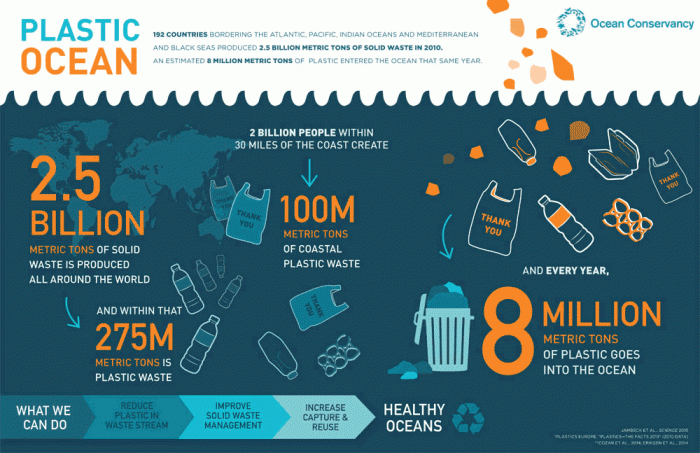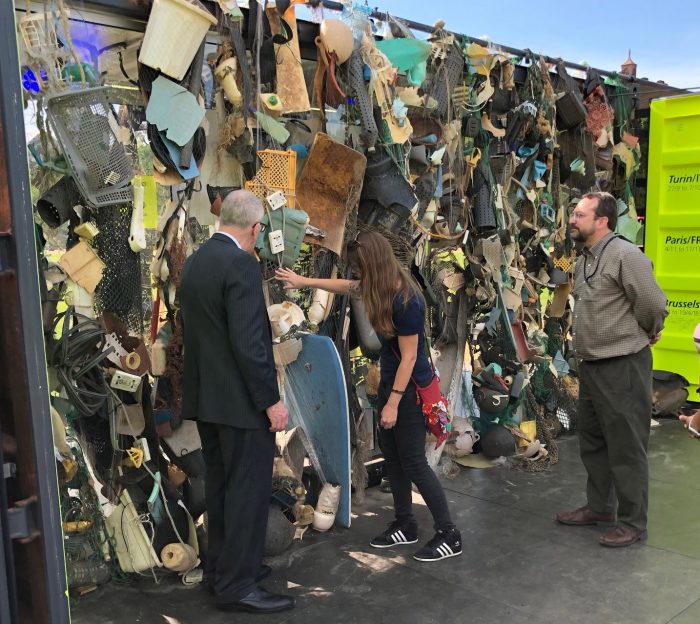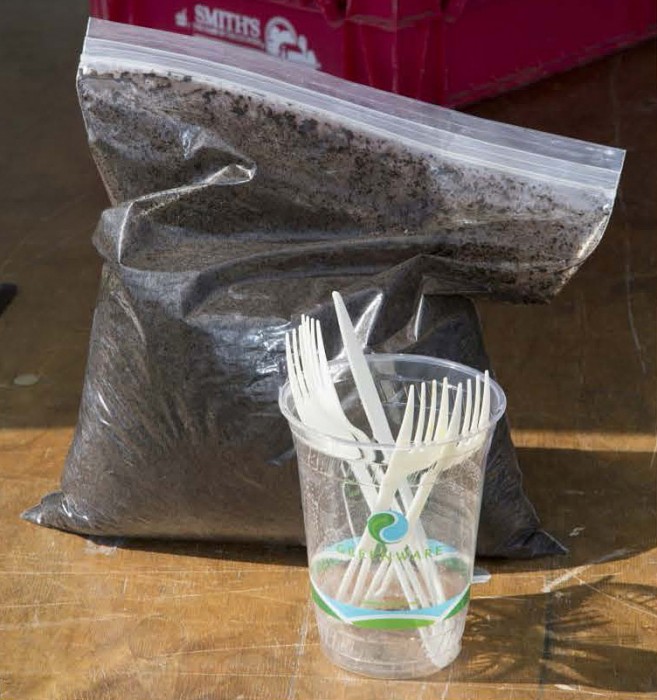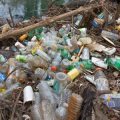Plastic or Planet?
The world dumps the equivalent of a garbage truck of plastic into the ocean every minute of every day, year after year. Secretary Skorton explains how the Smithsonian is trying to slow the deluge—and what you can do to help.

Plastic is such a convenient and ubiquitous part of our lives that most of us simply take it for granted: the stirrer in our morning coffee, the bottle of water with lunch, the plastic container of carry-out we grab on the way home.
But we are slowly being buried alive by these “conveniences,” most of which never disappear. Our planet’s oceans—the source of life on earth—are drowning in our trash. The Great Pacific trash vortex of floating debris is estimated to range in area from the size of Texas to almost six million square miles—the size of Russia. A 2015 study found that 90 percent of seabirds have ingested plastic and more than half of sea turtle species have eaten plastic debris. A beached whale in Thailand was found to have more than 17 pounds of plastic in its stomach after it died.
Our Smithsonian scientists have witnessed firsthand this growing global problem for our oceans, lakes, and streams, as well as their wildlife. Museum Conservation Institute Research Scientist Odile Madden collected Layson albatross chicks on the remote Midway atoll that may have starved to death or been poisoned when their parents mistakenly fed them plastic. National Museum of Natural History Vertebrate Zoologist Charlie Potter performed an autopsy on a bottlenose whale beached in Delaware and found that a plastic spray cap had lodged in its throat. Smithsonian Environmental Research Center Education Specialist Karen McDonald found microfiber plastics in the plankton of the Chesapeake Bay during a workshop with schoolchildren. And Smithsonian Institution Dive Officer Laurie Penland has swum through floating masses of plastic debris off Belize.
Every year, 8 million more metric tons of plastics enter our ocean in addition to the estimated 150 million metric tons that currently circulate our marine environments—the equivalent of dumping a New York City garbage truck full of plastic into the ocean every minute of every day for an entire year.
But nations and organizations everywhere, including the Smithsonian, are taking action to address the problem of ocean plastics pollution.
Earlier this year, the Earth Day Network launched a campaign to End Plastic Pollution. On Earth Day, April 22, I announced the One Smithsonian Plastics Reduction Initiative, or OSPRI, to find ways to reduce the Smithsonian’s use of plastics and increase our recycling of plastic waste. In particular, we will reduce the quantity of single-use disposable plastics, such as water bottles, provided to our visitors. Similarly, in May, the European Union proposed a ban on 10 single-use plastic items that make up 70 percent of all litter in EU waters and on beaches, including plastic straws and bottles. And on World Environment Day, June 5, United Nations Secretary-General Antonio Guterres and U.N. Environment Program head Erik Solheim marked World Environment Day with a call to rid the world of single-use plastics.
On June 8, we celebrated World Ocean Day, when I announced our main focus this year is to prevent plastic pollution and encourage solutions for a healthy ocean. The outdoor interactive exhibit Ocean Plastics Lab is on the National Mall between the Castle and the National Museum of Natural History through June 17. Sponsored by the National Oceanic and Atmospheric Administration and other organizations, the Ocean Plastics Lab brings attention to the global problem of ocean plastic pollution and highlights science-based solutions.

Secretary David Skorton (left) and Eric Hollinger of the Natural History Museum listen as Julia Schnetzer from the Germaine Marine Research Consortium describes the Ocean Plastics Lab exhibition on the National Mall June 14. (Photo by Sarah Sulick)
The Smithsonian has already taken some steps to move away from single-use disposable plastics. For example, The Friends of the National Zoo have converted all bags at their retail shops from plastic to paper. The Center for Folklife and Cultural Heritage’s (CFCH) annual Smithsonian Folklife Festival once produced mountains of Styrofoam and other plastic waste each summer, but by altering its vendor contracts to require the use of compostable materials and organizing the collection and diversion of waste, the Festival has succeeded in diverting up to 96 percent of its waste and almost completely eliminated its plastic trash. The Festival’s sustainability program received the American Alliance of Museums’ Sustainability Excellence Award in 2017, as did the National Museum of the American Indian.
CFCH has also reduced the use of bottled water by offering free water refill stations during the Festival.
The Office of Facilities Management and Reliability is working to reduce dependence on disposable water bottles by installing 42 water refill stations across the Institution, in both public and staff areas. OFMR currently plans to add nine more refill stations, so that staff and visitors alike can stay safely and affordably hydrated without the use of disposable plastics. To date, 1,248,652 water bottles have been refilled at the stations, meaning that many fewer 16-oz. disposable plastic bottles have gone into the trash.
In addition, Smithsonian Facilities reports that almost half (45.86 percent) of all the trash produced by the Smithsonian in FY2017 was composted. And that doesn’t even include an impressive 2,000 cubic yards of herbivore manure recovered at the Zoo and the Conservation Biology Center and composted into “Zoo Doo” (special recognition is due to the efforts of the team at Elephant Trails!)
Restaurant Associates, the contractor for the Smithsonian’s cafés and restaurants, has been composting organic waste—305 tons in FY 2017—at the Museum of Natural History, the American History Museum, the American Indian Museum, and the Museum of African American History and Culture for the past few years. RA uses compostable dishes and cutlery when possible to reduce waste even further. The café at the Natural History Museum, which had been composting approximately 180 tons of waste each year, is currently undergoing renovations that will include dishwashing facilities, allowing for reusable plates and cutlery when it reopens, thus reducing its use of dishes that must be composted. The Mitsitam Café at NMAI and the café at NMNH were awarded Three-Star Certification by the Green Restaurant Association for their comprehensive sustainability efforts.

These compostable utensils, made from corn, will become nutrient-rich soil in just eight weeks. (Photo by Francisco Guerra)
OSPRI will build on this progress and strive to eliminate the single-use disposable plastics provided to our visitors wherever possible. Where it may not be possible to eliminate them entirely, we will seek to reduce their use and continue to research alternatives that will ultimately allow us to convert to non-plastic alternatives.
Our success will depend on the collective experience, knowledge, and efforts of all our Smithsonian units working together. The initiative’s Working Group is co-chaired by Nancy Bechtol, director of Smithsonian Facilities and Chief Sustainability Officer; Dennis Kelly, interim president of Smithsonian Enterprises; and Steven Monfort, acting director of the Zoo, director of the Conservation Biology Institute and chair of the Smithsonian Conservation Commons’ Steering Committee.
In the coming months, the Working Group invites interested staff to contact them with ideas and suggestions for accomplishing this bold challenge. I, for one, will be changing my personal use of disposable plastics, and I encourage everyone to send their ideas to the Working Group at SI-OSPRI@si.edu. With your help, I am confident that this initiative will be a success, and I will be able to report great progress by the 50th anniversary of Earth Day in April 2020.
Thank you for all you do on behalf of the Smithsonian.
Posted: 9 July 2018
- Categories:









Excellent article!
It is a matter of being willing to sacrifice a little convenience for what is best for the environment, my kids and future grandchildren.
I can make wiser personal choices… I can chose to bring my own water container and refill it as many times as I want to and do a little exercise in getting to the refill station, or to buy bottled water at Sam’s. If wanting a soft drink (in Panama), I can choose to drink it from returnable glass bottles, or from recyclable aluminum cans, or from single-use plastic bottles that end up in the trash. The first two choices will allow me to drink less of the tasty, yet not-so-good-for your-health liquid. The choice is mine and… yours.